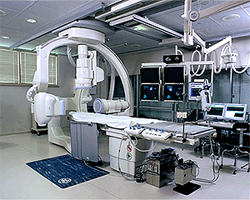 Percutaneous Transluminal Coronary Angioplasty (PTCA)
Percutaneous Transluminal Coronary Angioplasty (PTCA)
In some cases coronary arteries are too severely blocked for medical treatment alone. Your doctor may suggest a revascularization procedure such as angioplasty or stenting. During an angioplasty, a catheter with a balloon on the end of it is threaded up to the arteries that supply the heart. The heart and it’s blood vessels are imaged by an x-ray machine while this is done. This way, the doctor can see exactly what area of the coronary artery is narrowed. The balloon is then positioned in that area and inflated to open the artery. To see a graphical representation of this, please click here. If the blood vessel is large and may re-narrow after the procedure, a stent may be used. A stent is a hollow slotted tube that is threaded on a balloon catheter and placed in the coronary vessel at the place of narrowing. There is a chance that the stented area may narrow with time but it is less than with balloon angioplasty alone. Pictures of the stenting procedure can be viewed here.
Coronary Artery Bypass Graft Surgery
The coronary artery bypass graft or CABG procedure involves using an artery in the chest wall or removing veins from the legs and grafting them to coronary arteries. A healthy vessel is used as a detour around the diseased area. In this way, the narrowed area of the coronary artery is bypassed and blood flow to the heart muscle redirected.
Valve Surgery
Severely blocked or leaky heart valves can be repaired or replaced by a heart surgeon during an open heart operation. Tissue valves (usually from pigs) often do not require the patient to take blood thinners. Mechanical valves can last longer than tissue valves but do require blood thinners.
Heart Transplantation
In end stage heart failure, the best option may be replacing your worn out heart with a new one. Unfortunately, there are fewer donor hearts than are needed by patients. Because of the shortage of donors, heart transplant recipients may wait months or years for a new heart. Currently, cardiac transplantation survival in appropriate individuals is 95% perioperative, 85% one year after transplantation, and 65% five years after transplantation. Click here for more information
LVAD
Some patients not candidates for heart transplant, may benefit from placement of a left ventricular assist device (LVAD). Click here for more information


 Español
Español












